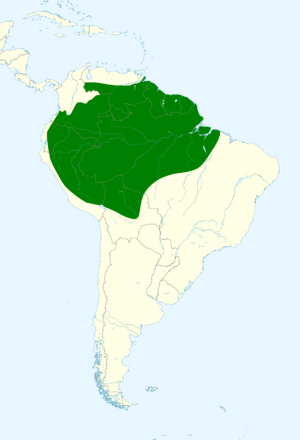Bidentate yellow-eared bat facts for kids
Quick facts for kids Bidentate yellow-eared bat |
|
|---|---|
| Conservation status | |
| Scientific classification | |
| Genus: |
Vampyriscus
|
| Species: |
bidens
|
 |
|
| Synonyms | |
|
Vampyressa bidens |
|
Meet the bidentate yellow-eared bat (Vampyriscus bidens)! This cool creature is a type of bat that lives in South America. It belongs to a bat family called Phyllostomidae, known for their unique nose shapes. Scientists used to think it was part of a different group, but now they know it's in the Vampyriscus genus.
Contents
What Does This Bat Look Like?
This bat is quite small. Its body, from head to tail, is only about 5 to 6 cm (2.0 to 2.4 in) long. It weighs around 12 g (0.42 oz), which is about as much as a few coins! Male bats are usually a bit bigger than females.
Its fur is mostly light to dark brown. The fur gets a little lighter on its neck and shoulders. On its belly, the fur fades to a grayish color.
This bat has some cool markings on its face. It has white stripes on each side. One wider stripe is above its eyes. Another thinner, less clear stripe runs along its cheek. The edges of its ears and a special part inside its ear, called the tragus, are bright yellow. The edges of its nose-leaf are also yellow.
Unique Features of the Bidentate Bat
The bidentate yellow-eared bat has a short, wide snout. It also has a special, spear-shaped nose-leaf. This is a fleshy growth on its nose that helps it with echolocation, like a radar system.
The "bidentate" part of its name is interesting. It means "two teeth." Most other yellow-eared bats have two pairs of incisors (front teeth) in their lower jaw. But this bat usually has only one pair. However, some of these bats can still have two pairs, just like their relatives!
Where Do These Bats Live?
The bidentate yellow-eared bat lives in many parts of northern South America. You can find them east of the Andes mountains. This includes eastern Colombia, Ecuador, and Peru. They also live in southern Venezuela, northern Bolivia, and Brazil. You can find them throughout the Guyanas too.
They prefer to live in lowland evergreen forests. They also like swampy areas. These bats are found at elevations between 200 and 1,000 m (660 and 3,280 ft) above sea level.
Bat Life: Habits and Diet
The bidentate yellow-eared bat is a plant-eating animal, also known as a herbivore. It loves to eat fruit, especially figs.
These bats are nocturnal, meaning they are active at night. They fly more often around sunset than before sunrise. During the day, they rest and sleep in trees. Young bats are usually born during the rainy season.


